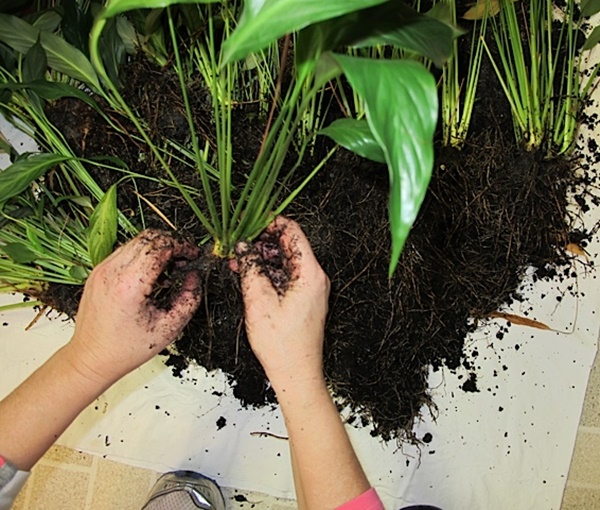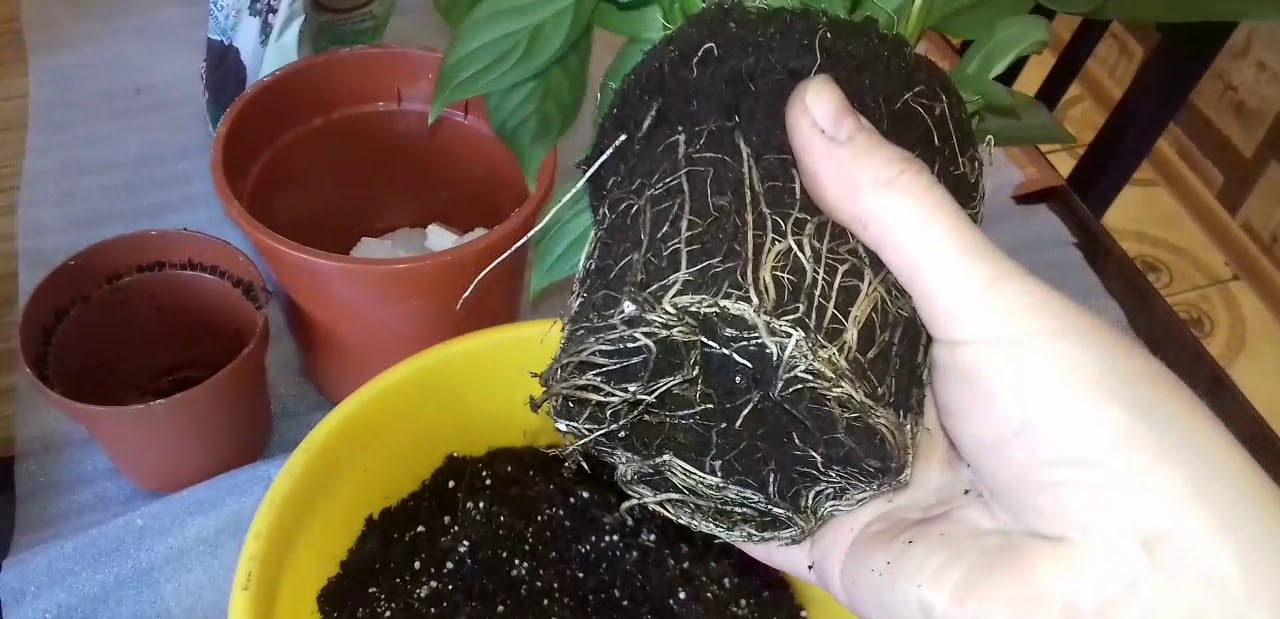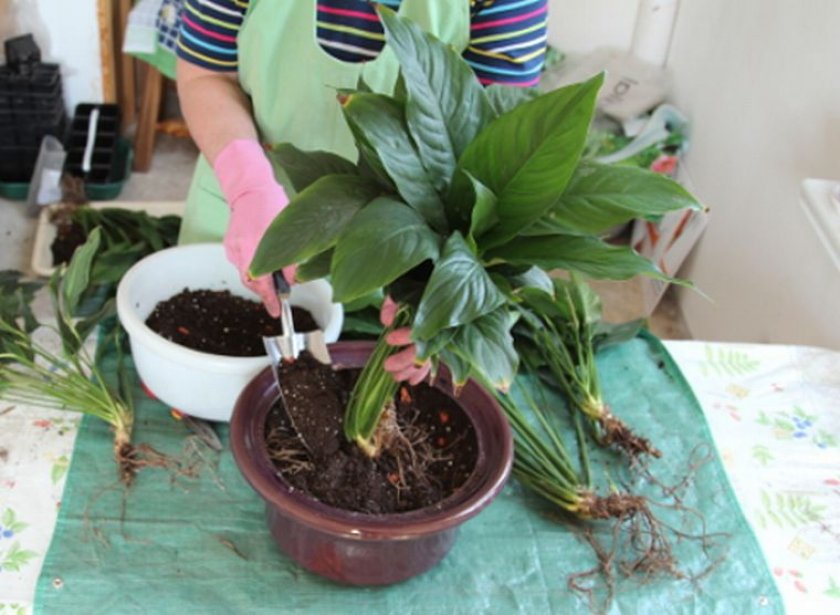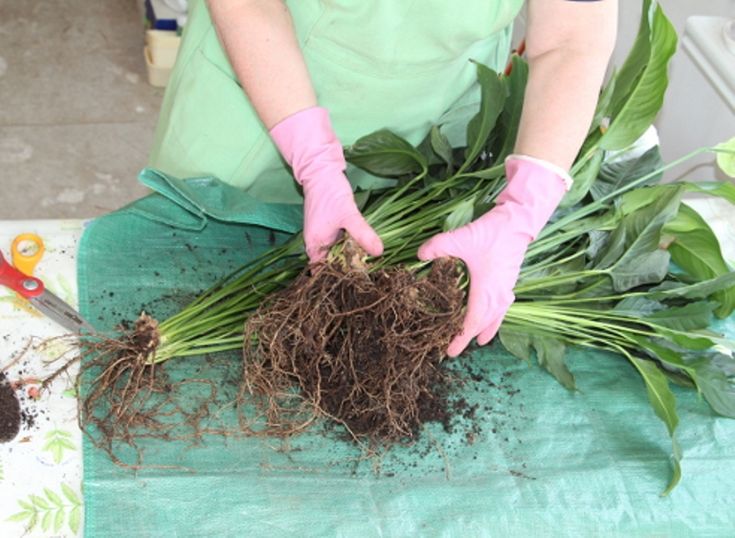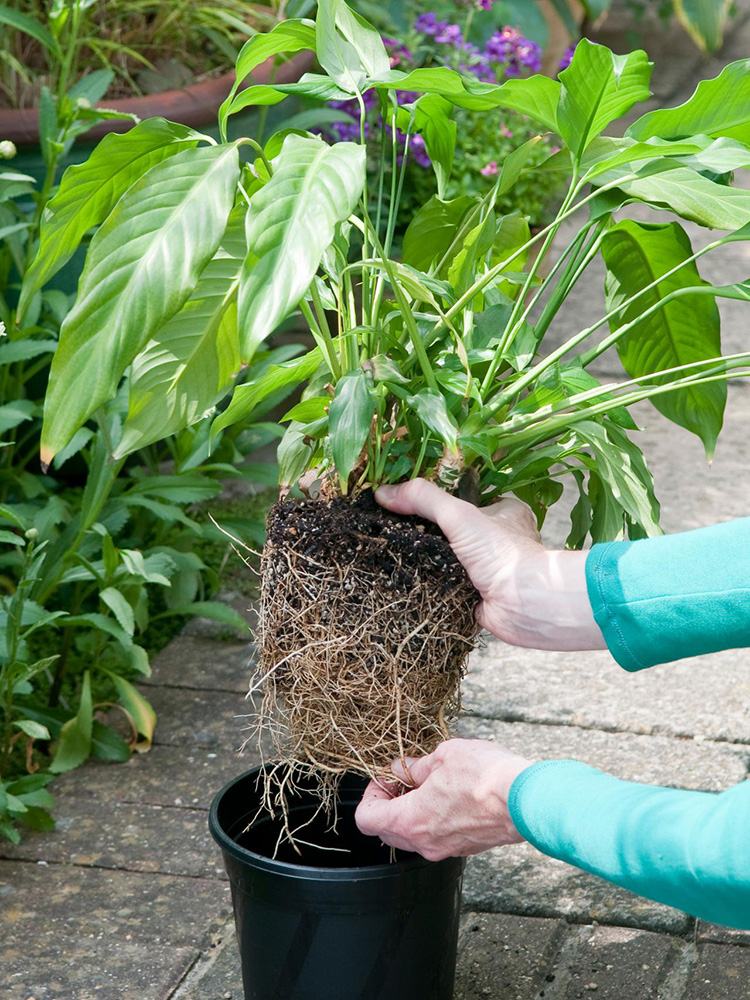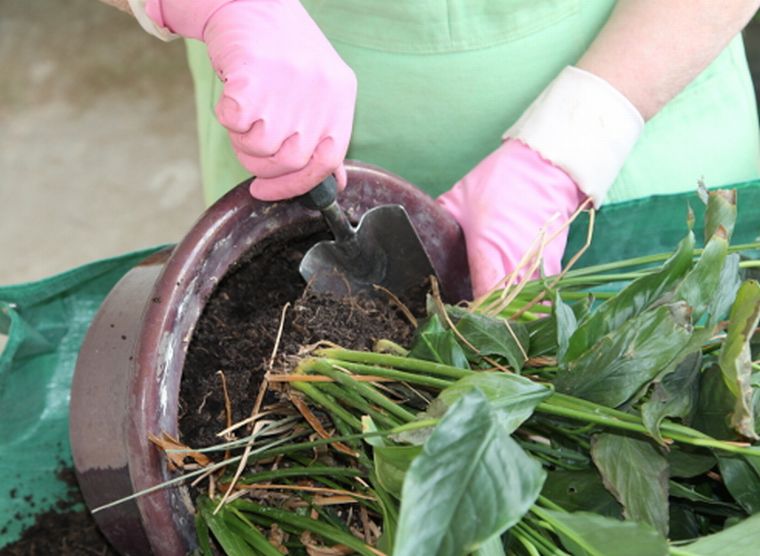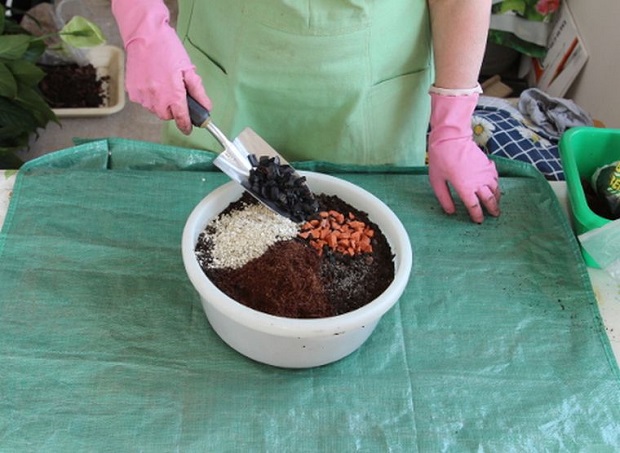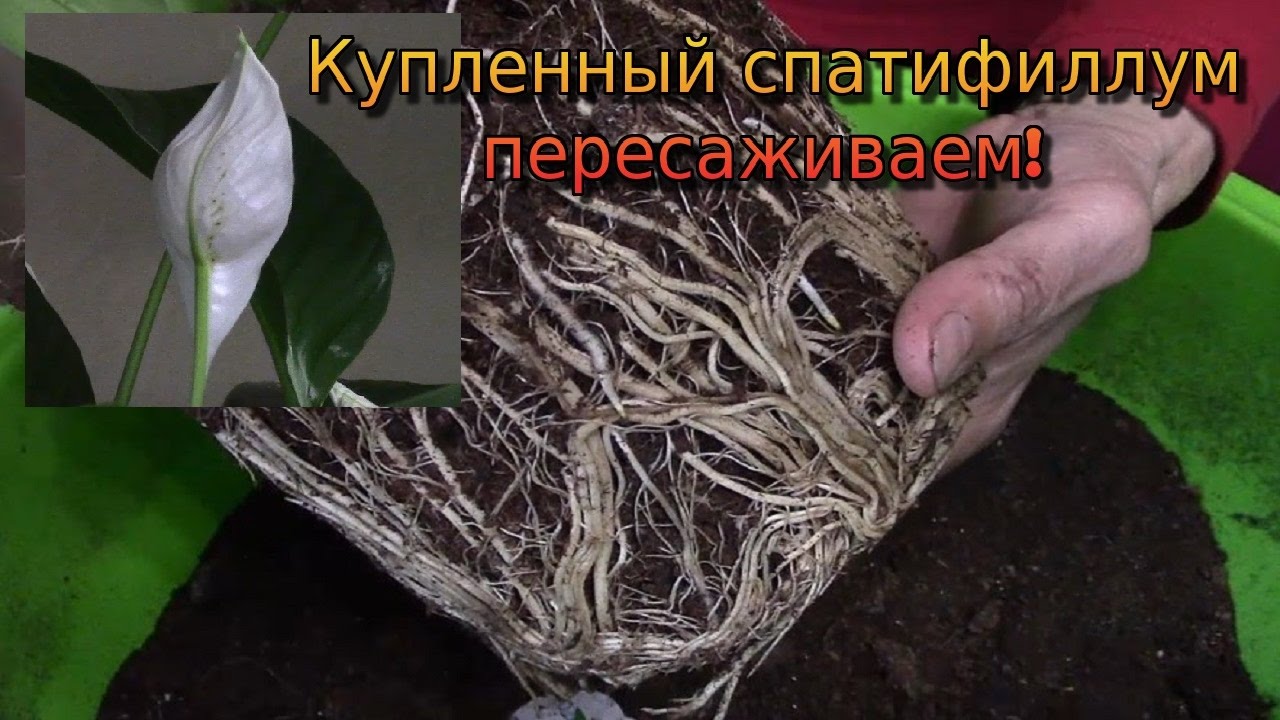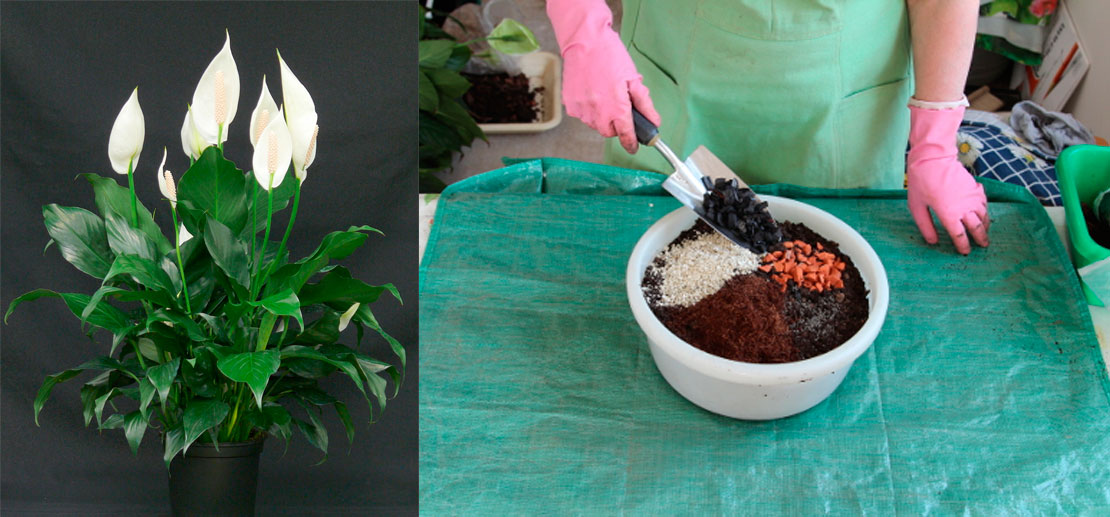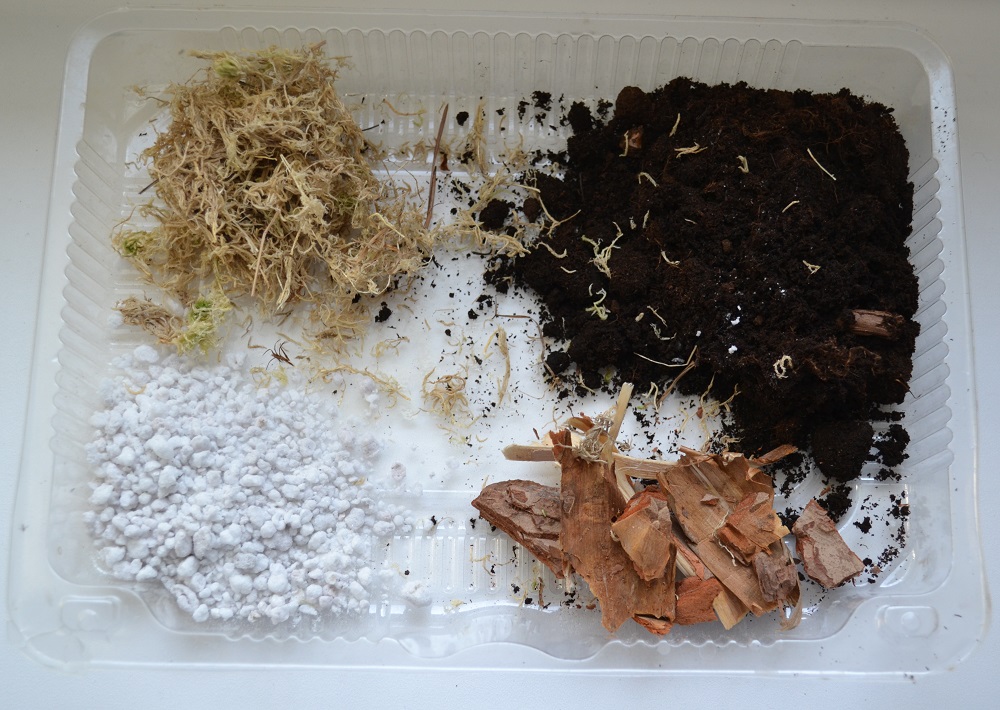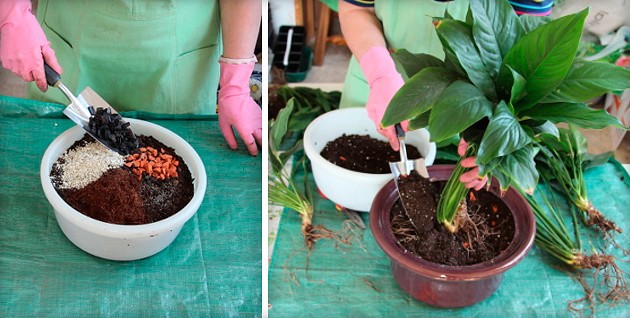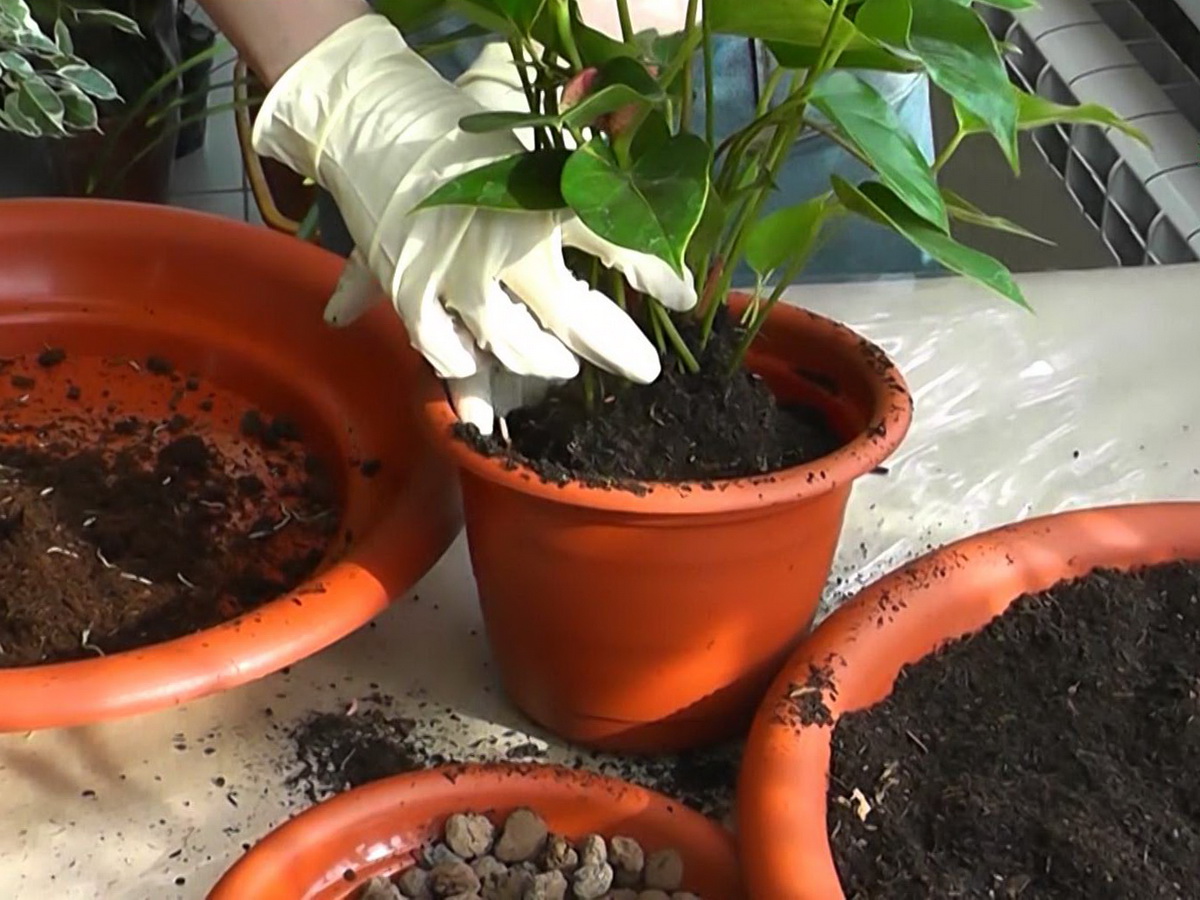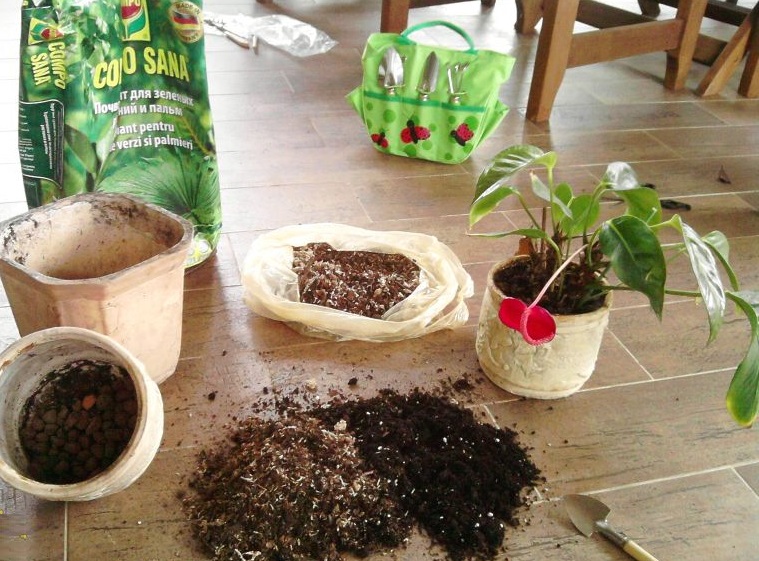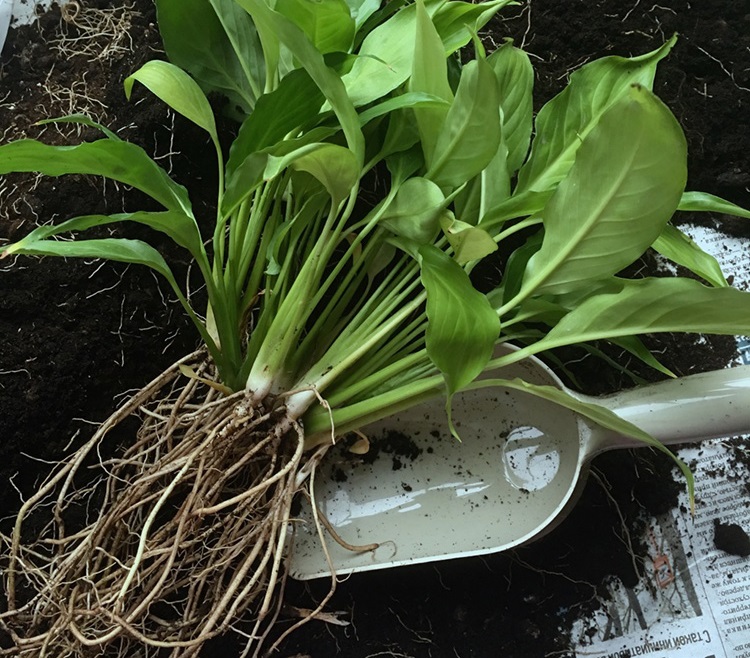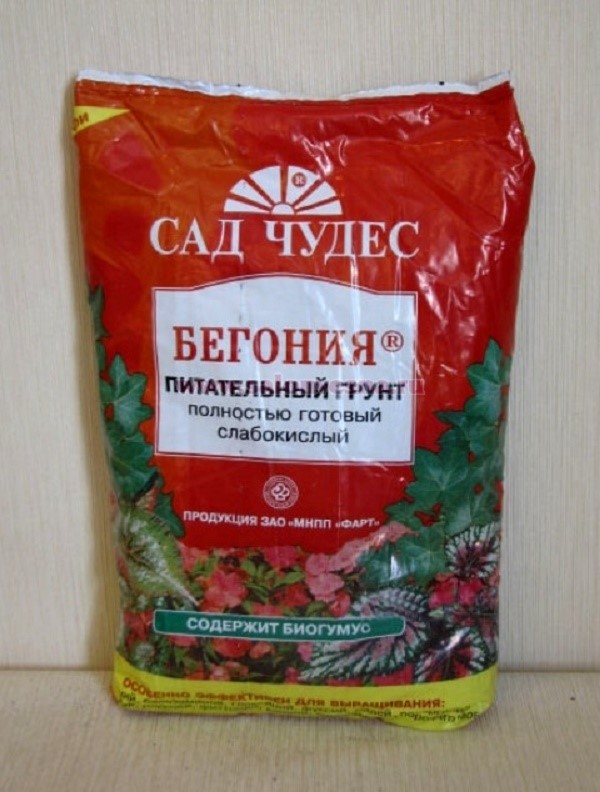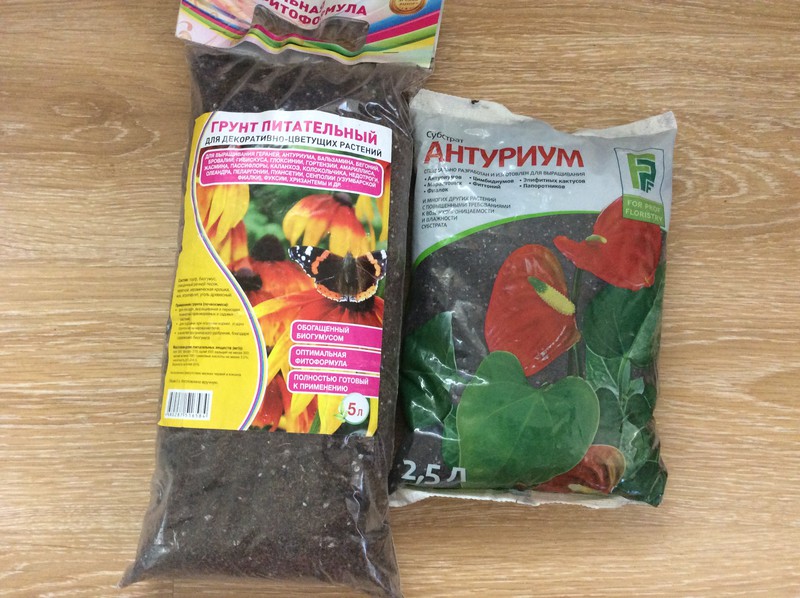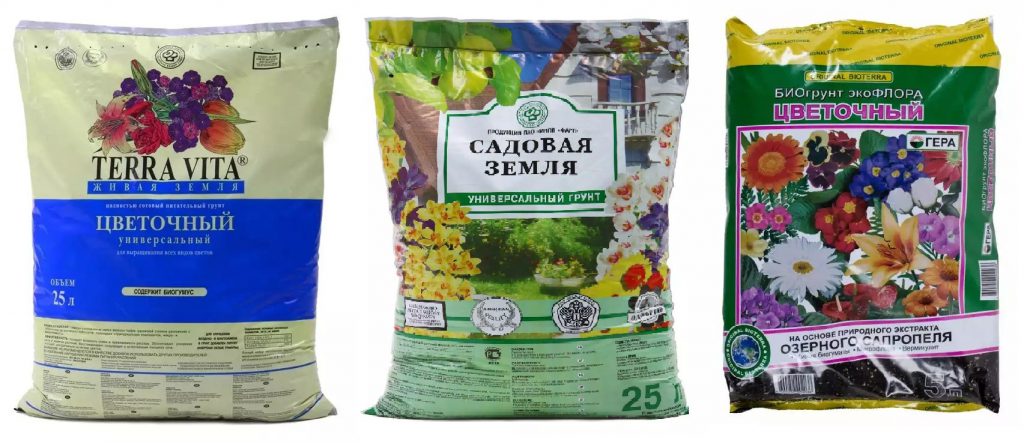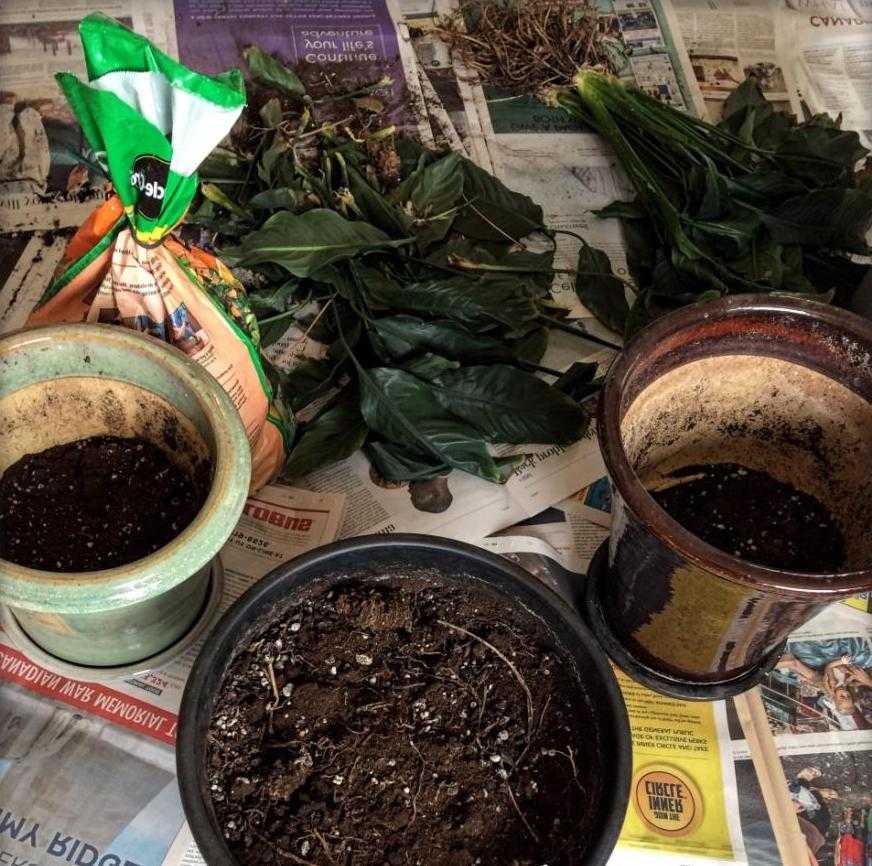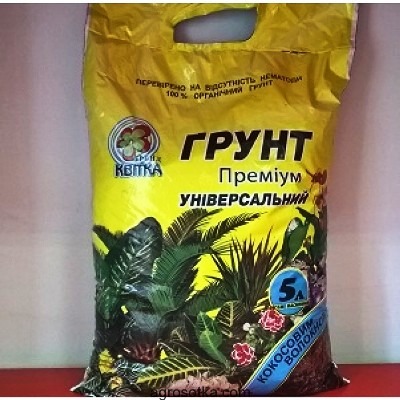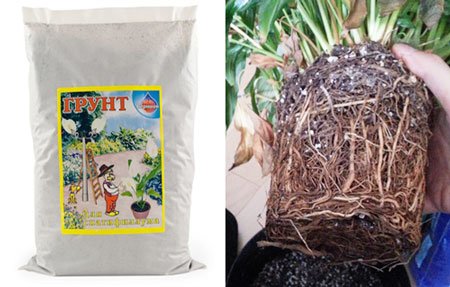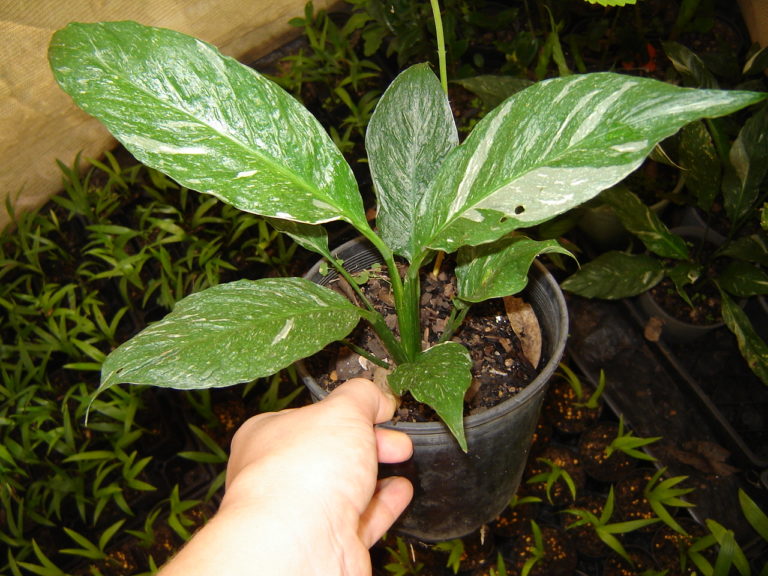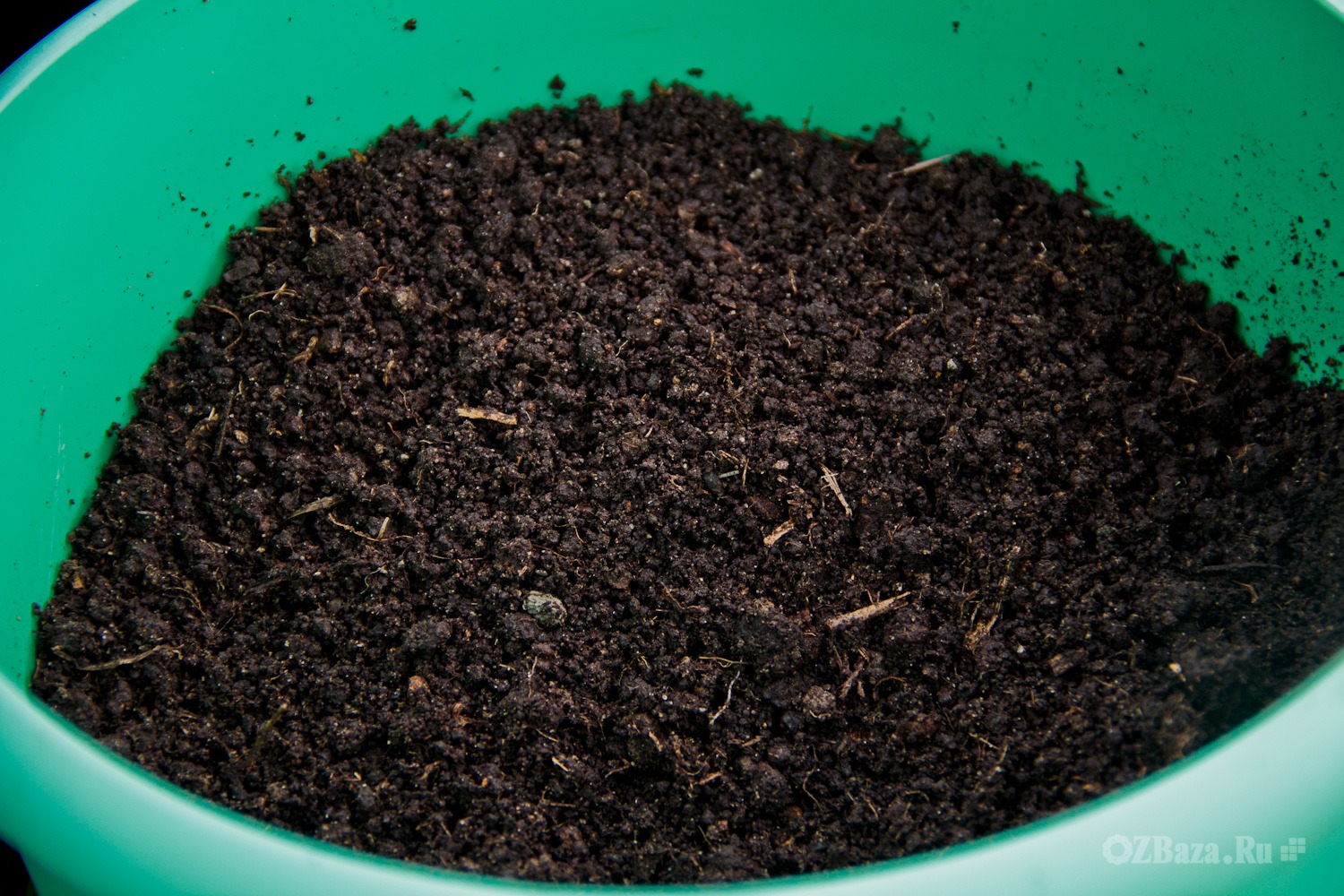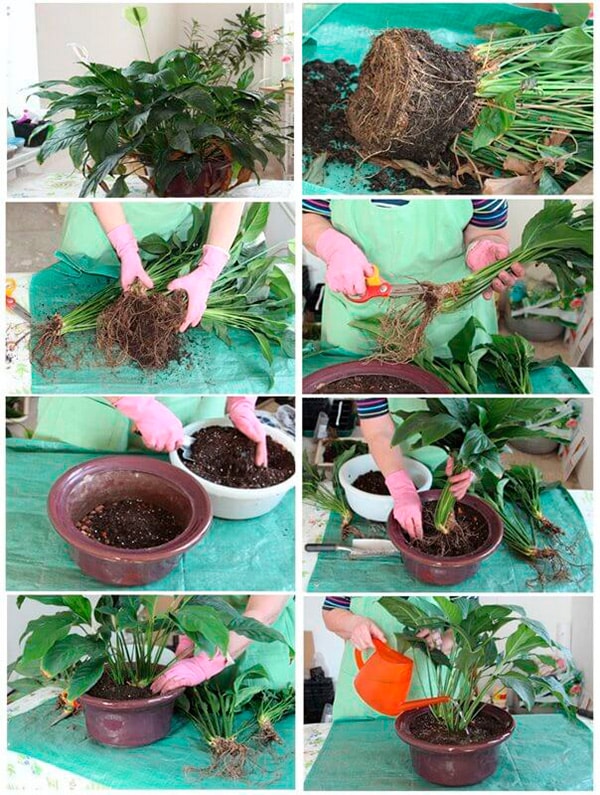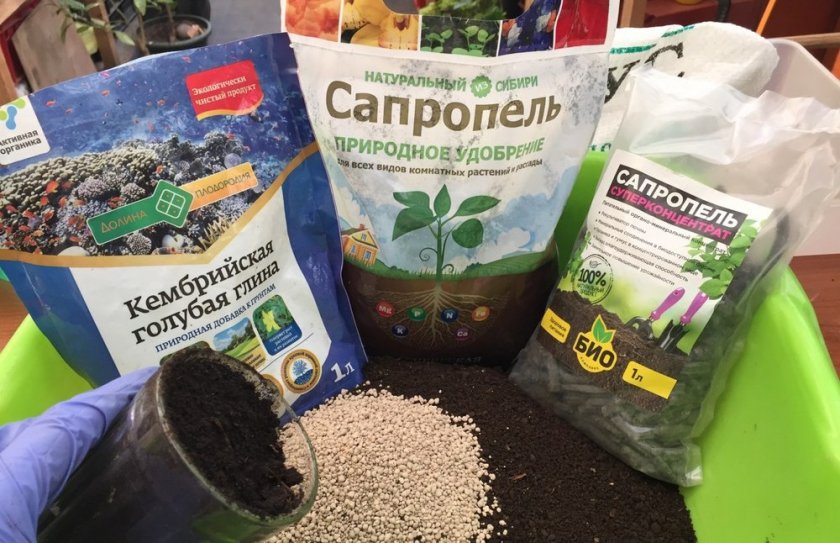Step-by-step instructions for an autumn transplant of spathiphyllum
The sequence of actions is as follows:
-
We select a new pot for spathiphyllum. The planting capacity should not be too spacious and high, because this tropical culture blooms only after it has completely mastered and braided the whole clod of earth with its roots. It is better to choose a pot only slightly (2-3 cm) in diameter larger than the previous one.
- We prepare the soil mixture. You can purchase a ready-made soil composition or prepare it yourself from:
- garden sod land - 4 parts;
- leaf land - 2 parts;
- low-lying peat - 2 parts;
- coarse river sand or perlite (vermiculite) - 2 parts;
- crushed wood ash - 1 part;
-
coconut fiber and small pieces of tree bark - 1 part.
-
We remove the flower from the old container. A few hours before this, the spathiphyllum needs to be thoroughly moistened so that the earthen lump can be pulled out more easily. If it doesn't work, then you can turn the pot over and gently tap it around the perimeter or use a knife to separate the soil from the walls.
-
We release the root system, which is a dense ball of roots, from old drainage and remaining soil.
-
We remove all peduncles, dried leaves and rotten or damaged roots.
-
At this point, the bush can be split into separate outlets.
-
Pour a drainage layer (1.5–2 cm) into the pot from broken shards, pebbles, expanded clay, etc.
- We fill the planting capacity with the substrate by about a third.
- Place the plant in the center, evenly distributing the roots on different sides.
-
Fill up the soil mixture and slightly crush it. The soil level should reach the rudiments of aerial roots present at the base of the stems.
-
Water and expose for 7-10 days in a slightly darkened place.
Stages of spathiphyllum transplant
- Land preparation. It is correct to buy land for transplanting spathiphyllum at home in a specialized store. So the composition and concentration of nutrients will meet the requirements of the plant. If there is no opportunity to buy ready-made soil for spathiphyllum, then you can prepare it yourself. You need to transplant into slightly acidic soil. It is made up of sod land, leaf, peat, coarse river sand. It is also recommended to add additives to the composition of the earth in the form of charcoal, brick chips, superphosphate.
-
Preparing a pot or planter. The choice of container for transplanting spathiphyllum at home depends on the size of the old pot. If you plan to leave the plant intact, without planting the children, then you should take a pots two or three sizes larger than the previous one. When planting, you will need additional containers for new plants. When choosing from which material the new container will be, you should give preference to natural clay. A drainage layer of expanded clay (2 cm) must be laid on the bottom of the new pot.
- Plant preparation for transplantation. On the day of the planned transplant at home, the spathiphyllum pot is well spilled so that the soil becomes moist. This will make it easier to remove the plant from the pot and, if necessary, divide the rhizomes. With a garden spatula, you need to walk along the edge of the old pot, digging in the roots. The plant, together with the earthen lump, is pulled out of the container. The roots of an adult plant tightly entwine the entire soil. It is at this stage that spathiphyllum blooms. The root system must be gently cleaned of drainage and old soil. If the plant has flower stalks, then it is worth cutting them off with a pruner so that it will use all its strength to take root in a new pot.Dried and withered leaves are carefully removed or, if it gives in, cut off.
-
Division of the rhizome. Several outlets can be separated from the entire mass of plants. This is the easiest way to reproduce spathiphyllum at home. If it has not been transplanted for a long time, then there may be a lot of young plants in the pot. Separating the children, the main task is to preserve a powerful rhizome behind each rosette of leaves. After dividing, the roots should be examined. Rotten and too long pruning.
- Planting spathiphyllum. To transplant spathiphyllum according to the rules at home, you need to follow simple tips. You need to transplant carefully. Prepared soil is poured to half the volume on expanded clay, laid on the bottom of a pot or pots. Spathiphyllum is placed in the middle of the pot, the root system is spread over the surface. Next, add the substrate to the desired level. The plant should not be deeply deepened into the soil, even if the rudiments of the roots do not reach it. After a while, they will reach the ground and strengthen the flower even better. When the soil is poured, it should be tamped a little so that the plant does not sway and sits tightly in the ground. Then planting spathiphyllum is watered abundantly to eliminate voids in the soil. If a depression forms at the end of watering, then it is necessary to fill up the soil and repeat the tamping and watering procedure. After all the manipulations, the leaves are sprayed to wash away dust and dirt.
- Transplanted plant care. In the first month in a new pot, spathiphyllum is very picky about moisture. Many gardeners even recommend equipping a mini-plate for him. This is pretty easy to do. You can put the plant together with the pots in a plastic bag and the greenhouse is ready. Spathiphyllum leaves need frequent spraying from a spray bottle. Spraying is best done early in the morning and at dusk and preferably twice a day. The soil should not be allowed to dry out, so watering should be done as soon as the topsoil dries up a little. To accelerate root formation, the plant can be watered once with "Kornevin" or another drug that stimulates the formation of roots. You can also use root or foliar dressing with special fertilizers. It should be remembered that the plant will not bloom until the root system completely encircles the pot from the inside.

Correct transplantation of spathiphyllum and care at home after it will help the plant recover in a short time and build up the root system. A healthy plant will delight you with lush flowering and beautiful succulent foliage.
Ground requirements for spathiphyllum
Before choosing a soil for a plant, you need to find out in what conditions it grows in nature. The homeland of spathiphyllum is the humid subtropics. It grows mainly along rivers, lakes or in wetlands. In such places, the soil is usually rich in humus and peat.
What should be the soil for spathiphyllum:
- loose;
- breathable;
- moisture permeable;
- easy;
- fertile;
- slightly acidic.
The acidity of the soil should be within 5.5. If the level of acidity is elevated, then dolomite flour, slaked lime or wood ash can be used to reduce it.
Note! To increase air permeability, river sand is added to the substrate. Good drainage is also required - pebbles or expanded clay
What is the composition of the soil is necessary for a flower female happiness
Before buying soil, you need to study the composition well. But before that, you need to figure out which ingredients must be included in the soil mixture, and which should not be there. For successful cultivation, you need to know in advance what kind of soil spathiphyllum loves.
What kind of land is suitable for spathiphyllum and what should be included in:
- sand, agroperlite or vermiculite;
- deciduous or sod land;
- peat;
- humus;
- superphosphate;
- charcoal.
The base is deciduous or sod land. It should be most of all in the composition. Peat and humus are added in the same amount. Ingredients such as sand, agroperlite and charcoal should take up no more than 10% of the total mass of the substrate.
Advice! You can use ground brick, small pieces of bark as a baking powder.
Should the land for planting and replanting be different
The soil for spathiphyllum, as well as for the closest relative of this Anthurium flower, during planting and transplantation, may be the same in composition. It is not necessary to change the composition of the soil with each transplant. You can even leave the drainage layer old, just rinse it thoroughly before replanting the flower.
In the summer, you can transplant the flower outdoors in open ground. It is planted along with the substrate in which it grew in a pot at home.
How to determine if the soil needs to be changed?
Alarms are easily identified by their appearance:
- Root outgrowths sprout through the drainage holes at the bottom of the pot.
- Pests (mites, aphids, cobwebs) were found on the surface of the topsoil and on the plant itself.
- When leaves, roots, stems are infected with rot, fungus, spot infections, they partially or completely change the soil.
- The flower itself is cut, transplanted, quarantined.
Why do you need to transplant spathiphyllum in the fall
An urgent transplant for women's happiness, as spathiphyllum is also called, may be needed in the fall for a number of reasons:
- There has been no flowering for a long time, the leaf blades are crushed and look withered. These are signs of severe depletion of the soil mixture when a complete replacement of the soil in the pot is required.
- Brownish-brown aerial roots have crawled out onto the surface of the soil, which simply do not fit in the planting container.
- The rosette of leaves has come out of the ground and is practically dangling in the air.
- The flower has grown too much, forming a lot of children. With a high density of plants, not everyone has enough nutrition and young, just crawled, leaves begin to fade and dry out.
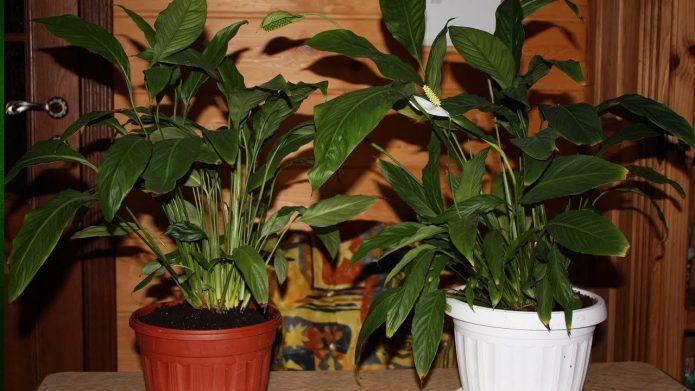
Spathiphyllum may need a transplant in the fall
Spathiphyllum usually blooms twice a year. As soon as I notice that he has been standing without flowers for several months, I immediately start a transplant. This plant firmly endures all manipulations even in winter, so I never wait for spring. The only thing is that at this time I try not to injure the root system much and do not divide the bushes.
How to transplant spathiphyllum - care rules or how to avoid trouble
Spathiphyllum is a tropical flower, so long-term contact with the sun is undesirable for it, but if you put it in the back of the room, you will need to make a special backlight for it.
The comfortable temperature, in principle, does not fluctuate too much.
So average and ideal is about 20 degrees, give or take two.
Watering:
- From early spring and mid-late autumn, it is rarely required, but at the same time, it is necessary to water abundantly.
- Some time after watering, you need to wait about half an hour, plus or minus 10 minutes.
- In the event that water remains on the surface, then it is required to drain it.
- The abundance of moisture is unacceptable - the roots begin to rot, but even without water, "happiness" will not last long.
- The water must definitely settle or be soft.
In addition to watering, it is also necessary to spray it, the procedure must be performed several times a day.
Important! Air humidity - it should not exceed 70%, otherwise, he will feel extremely uncomfortable and will gradually begin to die off.
We need mineral fertilizers containing similar components: potassium, phosphorus and nitrogen.
Equally acceptable and, one might even say, desirable: molybdenum, manganese, copper and iron.
How to know when to transplant a flower?
In most cases, the flower itself makes it clear when it is time for him to change the pot, for something larger.
It's very important, everything is extremely simple: if you see protruding brown roots and swayed rosettes, then it's time to change the habitat of your tropical neighbor.
Also, the plant will give you a sign with its shrinking leaves.
That's just, they can also dry out from a lack of moisture.
In order to check for sure, you need to move the curtain apart and check the lower leaves. Have they started to dry out?
Spathiphyllum needs an urgent transplant.
Do they just wither?
Need to water, spray or place in a darker area.
A transplant can be done even when the flower is starting to grow or has already grown. However, at the time when it begins to bloom, it is undesirable to touch.
Usually, a transplant for spathiphyllum is carried out every 3-5 years and the ideal recommended season for this is spring.
However, for flowers like "Women's Happiness", this does not play a big role, so it will be enough that the room will be at least +20 degrees.
Differences between transfer and transfer
As a rule, purchased spathiphyllum is simply dumped out of their old vase together with clods of earth, and later they are arranged in a new flowerpot with a larger diameter and with pre-prepared soil already poured to the bottom.
A transplant, on the other hand, implies the complete removal of these clods.
That is, not only the flowerpot itself changes, but also the substrate to a fresher one.

Disinfection of the earth before planting or transplanting spathiphyllum
Disinfection of self-prepared soil is an important stage in planting a flower. Quite often, when using land from the site, insects appear some time after planting the house. The thing is that pests lay eggs in the ground, and when the larvae hatch, they begin to eat the first plants that come across. This creates problems not only for spathiphyllum, but also for all other indoor plants.
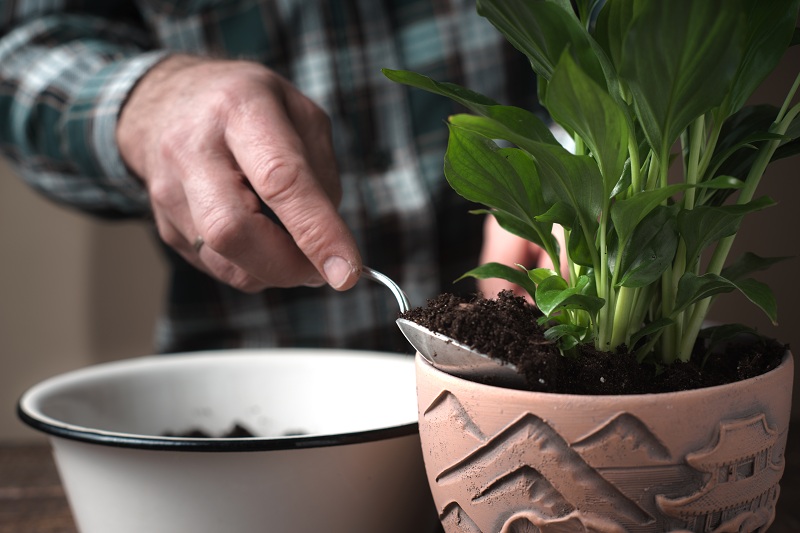
Planting a plant
Soil disinfection methods:
- Double freezing of the soil. This method consists in the fact that the soil will need to be frozen in the freezer. But freezing alone will not be enough. Most microorganisms survive a drop in temperature calmly. After the first freeze, you need to put the soil in a warm place and water it. This will be a signal to the larvae that winter is over and warmth has come. Then the soil is re-placed in the freezer after a few days (4-6 days). After the second freeze, all larvae and insects will die.
- Using boiling water. To do this, you need to bring water to a boil and pour plenty of boiling water over the soil. Then you need to cover the container with polyethylene and wait until the soil has cooled to room temperature. This is the easiest and fastest way.
- The third way is to use a solution of potassium permanganate. To do this, you need to prepare a strong solution of potassium permanganate and pour it over the earth. After a few days, you can start the transplant.
Important! It is desirable to process not only homemade, but also purchased mixtures. Experience shows that not every substrate is treated against pests.
When is a transplant needed?
A newly purchased spathiphyllum should not be immediately transplanted into a new pot. This even applies to a faded flower. After the purchase, he needs to acclimatize to the conditions of the new home. If the hostess is embarrassed by what an ugly "native" pot, then you can put it directly with the plant in a new one, temporarily hiding the old one.
Spathiphyllum should be put in a permanent place immediately. It will feel great on all windows except the south ones. Bright, direct light can burn leaves.
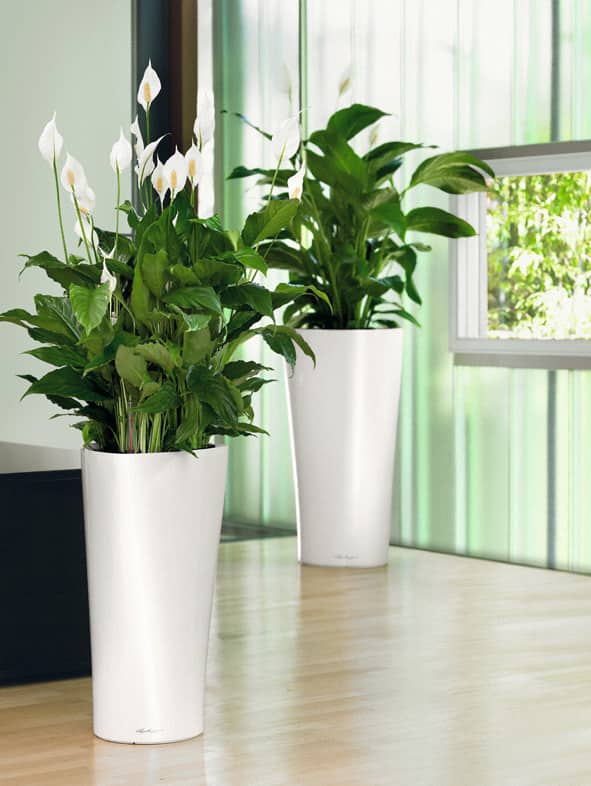
Spathiphyllum can be transplanted after acclimatization and flowering. Signals for a transfer are:
- High density of plants in a pot. Growing, the rhizome gives life to new shoots, which form their own rosette of leaves. With a high density of babies, young leaves begin to wither and dry out. This can be seen by expanding the green mass.
- The appearance of brown roots on the surface of the earth.This serves as a signal that the roots are running out of space in the pot, and a larger container is required.
- Leaf rosettes do not sit tightly in the ground. When wiggling, deciduous bunches give in easily. Such plants need to be planted urgently.
- Pulling out the earthen lump, it will be seen how densely the roots are located.
- The soil has lost its nutrients. We need a new fertile land.
The transplant time for spathiphyllum is not important, but there are three important rules:
- The plant should not bloom.
- More than a week has passed since the date of purchase.
- The air temperature in the room is not lower than 20 ° С
When the flower begins to grow wildly, most often in the spring, it needs to be transplanted. Due to the rapid growth of spathiphyllum, it is correct to transplant every year.
How to take care of the flower of "female happiness"?
Preparation for use and soil laying technology
Before planting a flower, it is necessary to process the pot, substrate and drainage. The pot is washed with soap, poured over with boiling water and allowed to dry. Landing in a wet container is strictly prohibited. The soil is disinfected.

This can be done in 4 ways:
- Drizzle with potassium permanganate solution (1%).
- Ignite in an oven or microwave at a temperature of + 90 ... + 100 ° С.
- Steam in a large container: pour 1/2 or 1/3 of water into it, put a colander on top, covered with a cloth, add earth, cover with a lid. The ground should be kept above boiling water for 20-30 minutes.
- Freeze twice.
The prepared soil is laid by hand, with a small scoop or spatula in the following sequence:
- Lay on the bottom of the pot, in which there must be drainage holes, drainage with a layer of 2 cm.
- Fill the container 2/3 full with soil substrate.
- Set the spathiphyllum in the center, spreading the roots.
- Pour the remaining soil so that 1–3 cm remains from the edge of the pot.
- Tamp.
- Drizzle.
- If the soil has settled, add it to the desired height.

How to water spathiphyllum
Don't keep the plant in a permanent swamp. Let the soil dry about a third of the pot between waterings. To test this, use a wooden stick with a blunt end.
Water the plant with water at room temperature or slightly warmer. From a cold, problems with the root system may begin.
Be especially careful during periods when the outside temperature is low. If you overmoisten a plant that is on a cold windowsill, the roots will begin to rot.
Spray spathiphyllum regularly, for example once every 1-2 days.
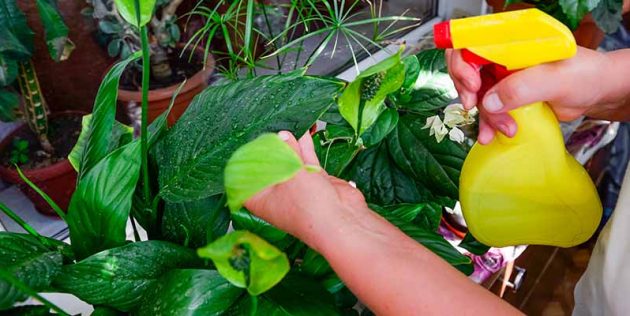
Once a week and a half, give the plant a warm shower - the water temperature should be slightly higher than room temperature. During the procedure, be sure to close the pot with a bag so that excess moisture does not get into the ground.
To increase the humidity, use an additional tray with expanded clay or sphagnum moss moistened with water.
How to transplant spathiphyllum
If you bought an imported "woman's happiness" in a store, do not delay its transplant. Do it after 2-3 weeks: transporting soil from a pot is not the best medium for good growth. Also, the roots can be enclosed in a net or cup, which will interfere with their normal development.
When replanting plants that have ended up in the ground and grown in local greenhouses, wait until the season is right.
Carry out a planned change of the pot annually, best of all in the spring.
Which pot to choose for spathiphyllum
The best option is a low and rather tight pot, 1–1.5 cm larger than the root system. In such conditions, the plant will not waste energy on filling the entire volume with roots.
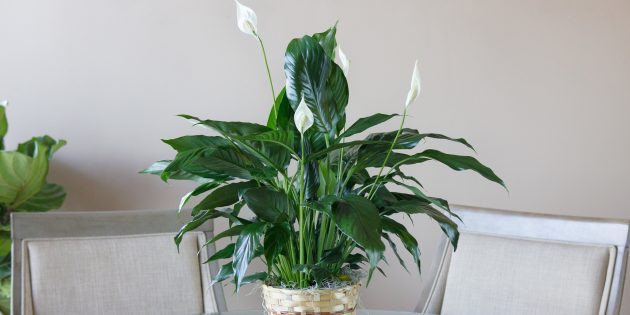
Which land to choose for spathiphyllum
Light, loose and permeable soils are suitable for this flower. For example, you can use special variants for aroids.
If there are none, make the soil mixture yourself. To do this, take a universal high-peat soil. Mix it with small pieces of pine bark.Additionally add some baking powder (perlite or vermiculite) and a few pieces of charcoal.
How to transplant
Remove the plant from the pot. Gently free the roots from the old soil. Cut off the rotten ones with a sharp knife. Treat the cut points with crushed activated carbon.
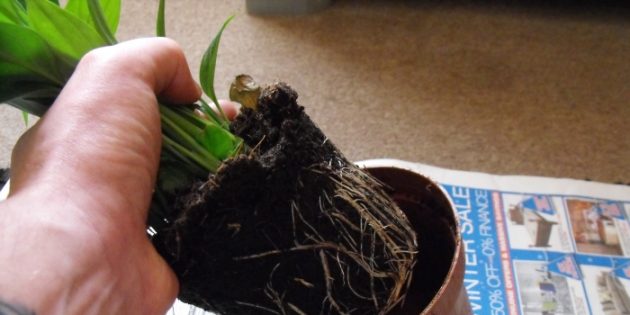
Do not over tighten with fit. Once the roots are in order, place them in a pot that has a drainage layer at the bottom (at least 1–1.5 cm) and some soil. Slowly fill in the rest of the earth and fill the voids inside the pot with it. Do not tamp too hard.
After transplanting, do not water the "woman's happiness" for 3-4 days. If the leaves begin to wilt, spray the plant several times daily.
How to fertilize spathiphyllum
Start applying top dressing only 1–1.5 months after transplanting. Previously, it is not necessary: in the new soil there is already enough of everything, and the plant during this time will cope with the stress from changing conditions.
Use organo-mineral fertilizers in the proportions recommended by the manufacturers. Apply them from spring to autumn at intervals of 2-3 weeks. Do winter dressing at half the recommended dosage.
How to treat spathiphyllum
Inspect the plant regularly. Its appearance will tell you if any mistakes are made in leaving.
The leaves went limp and sank down
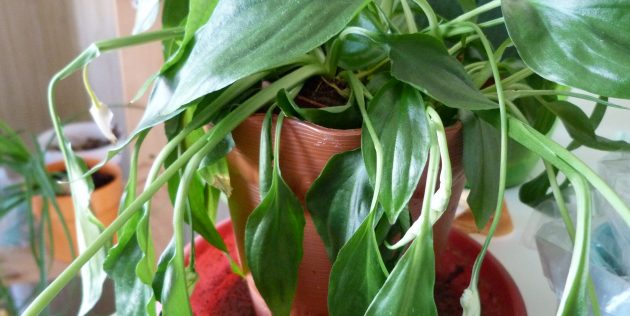
Reason: insufficient watering.
Once you notice a symptom, water the plant and spray liberally. Within a few hours, the leaves will return to their previous appearance.
If you do nothing and leave spathiphyllum without water for a long time, it will die.
The tips of the leaves dry
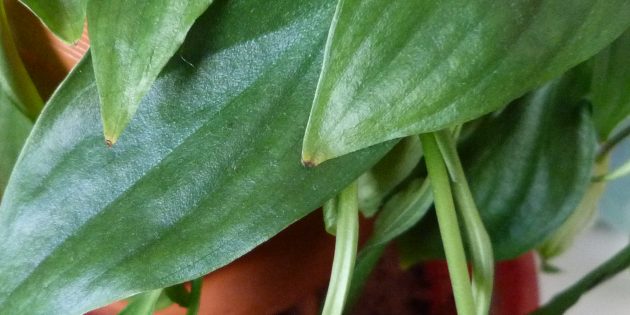
Reason: insufficient room humidity.
Try using a humidifier or place the flower and tray on a tray or plate moistened with sphagnum or expanded clay. Also spray and bathe the plant regularly.
Spots on the leaves
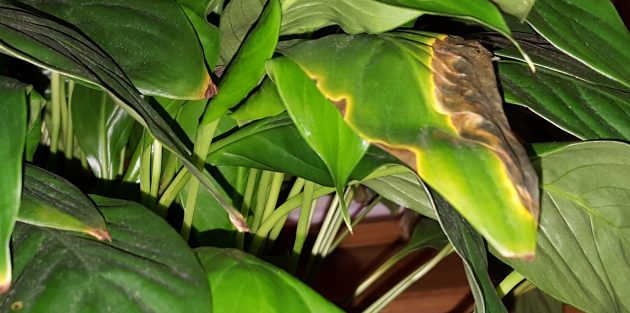 ask.extension.org
ask.extension.org
Reason: too frequent or heavy watering.
This is how the flower reacts to problems with roots suffering from a violation of the water intake regime. Try to water the plant as the topsoil dries, and do not water the potted soil.
- Place the plant in diffused light or partial shade.
- Protect from drafts and direct sunlight.
- Water as the soil dries.
- Spray and shower the flower regularly.
- Repot annually in the spring.
- Use light and loose soil suitable for the flower.
- Feed the plant with fertilizers.
1 The need to plant spathiphyllum
It is necessary to determine if the plant needs replanting. Usually spathiphyllum is transplanted in several cases:
- 1. The flower was recently purchased. Usually spathiphyllum is transplanted 2-3 weeks after purchase.
- 2. Poor quality soil in which the plant is located - too dense or containing too few nutrients.
- 3. The root system has completely entwined the ground, there is no room left in the pot. In such cases, the roots may even protrude above the ground or grow into drainage holes in the bottom of the pot.
- 4. A lot of time has passed since the last transplant - more than a year for a young plant (under three years old) and more than 2-3 years for an adult flower (which is older than three years).
- 5. "Women's happiness" stopped blooming, old leaves began to wither and become stained, and new ones began to appear much less frequently than before.
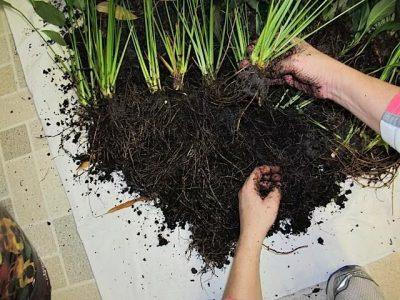
If the spathiphyllum meets any of the above points, it must be transplanted.
How to care
In order for the plant to develop normally, it needs to be provided with full and high-quality care.
Location and lighting
Spathiphyllum needs diffused lighting. The flower should be placed on the balcony, but it should not be exposed to direct sunlight.
It is important that the plant is not in a draft.
Temperature
If the plant is on the balcony in summer, it should be brought into the room long before the onset of cold nights. In winter, the temperature should not be less than +16 degrees. At + 10-11 degrees, spathiphyllum may die.

Watering
In the spring and summer, the culture should be watered abundantly. For this, it is recommended to use soft, settled water. With the arrival of cold weather, the amount of watering is reduced. If the flower hibernates in the room, it should be watered and sprayed sparingly.
It is important to avoid stagnant fluid
Humidity
The plant needs a fairly high humidity. The pot with the plant should be placed on wet expanded clay. Also, spathiphyllum should be periodically sprayed with water.
Features of choosing a pot
The plant needs a pot 2-3 centimeters larger than the size of the roots. It is not recommended to use too large a container. The roots should be a little cramped. Be sure to choose the right material. Plastic retains moisture, so it is best not to use it. The best option is a ceramic container. There should be drain holes at the bottom.
How to plant
Planting a plant is easy enough. In this case, it is not recommended to deepen the neck of the flower. Otherwise, the plant will not bloom. The earth should be compacted and watered a little. During the adaptation period, there is a risk of drying out the edges of the leaves. This is considered normal.
Top dressing and fertilization
It is recommended to fertilize spathiphyllum with mineral and organic substances. They are brought in one by one. Top dressing is used at intervals of 7-10 days in the summer. In winter, fertilizers should be applied once a month.
Why do you need
It is recommended to transplant the culture when the roots become very crowded in the container. This is best done in the spring.
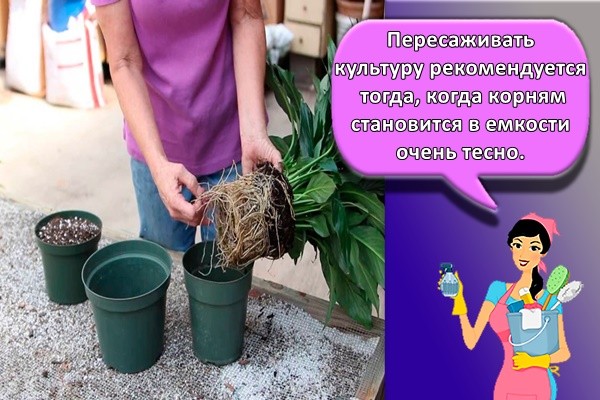
How often
Young flowers should be replanted every year. Plants over 5 years old are recommended to be moved to a new location when the roots are visible from the drainage hole.
Preparing for transplant
The procedure should be performed very carefully to avoid damage to the roots. For transplanting, it is worth using a mixture of sod and deciduous soil. It is also worth adding humus, peat and river sand to it.
How to transplant
First, it is worth pouring a drainage layer on the bottom of the container, after which it is worth placing a plant in it. Gently add soil on the sides and add a little earth on top. Then the plant should be watered.
Post-transplant care
In order for the crop to quickly adapt to new conditions, it should be sprayed frequently.
Warmth and moderate watering are also important. It is best to cover the flower with foil and air it twice a day.

